#Accessibility Standards
Explore tagged Tumblr posts
Text
Yall are reallll proud of calling a man your baby daddy before you can even call him your husband, stand df up how he put a baby in you before a ring on your finger😂
#tumblr girls#sprinkle sprinkle#pretty#just girly posts#shera seven#baby daddy#wife#baby mama#drama#husband material#stand up#high standards#accessibility standards#marriage
9 notes
·
View notes
Text
How to Choose the Right UI/UX Design Agency for Your Project
Selecting the perfect UI/UX design agency is a critical step in ensuring the success of your digital project. A well-designed user interface and user experience can significantly enhance user engagement, drive conversions, and bolster your brand identity. Here's a guide to help you navigate this important decision and find the ideal partner for your needs.
1. Understand Your Project Requirements
Before you begin your search, clearly define your project's goals, scope, and budget. Are you launching a mobile app, redesigning a website, or creating an entirely new platform? Knowing your requirements will help you communicate effectively with potential agencies and ensure alignment.
Key Considerations:
Target audience and user personas
Project timeline and milestones
Desired features and functionalities
2. Look for Relevant Experience
An agency's portfolio is a window into their expertise. Examine their previous projects to assess their experience in your industry or with similar project types. Look for case studies and testimonials that showcase their problem-solving skills and innovative designs.
Tip:
For specialized services, consider agencies with proven expertise. For example, Ynodesigns offers comprehensive solutions with experienced UX UI designers who understand diverse project requirements.
3. Evaluate Their Design Process
A transparent and structured design process is essential for delivering high-quality results. During your discussions, ask about their approach to:
User research and analysis
Wireframing and prototyping
Usability testing and feedback integration
This will give you insight into how they handle challenges and ensure a user-centered design.
4. Check Their Technical Capabilities
UI/UX design isn’t just about aesthetics; it’s also about functionality and performance. Make sure the agency is familiar with the latest design tools, technologies, and trends. Additionally, they should have a deep understanding of responsive design, accessibility standards, and performance optimization.
5. Assess Communication and Collaboration
Effective communication is key to a successful partnership. Choose an agency that prioritizes regular updates, listens to your feedback, and collaborates closely with your team. A reliable UI UX design agency like Ynodesigns ensures seamless communication throughout the project.
6. Review Their Pricing and Value Proposition
While budget constraints are important, the cheapest option isn’t always the best. Focus on value over cost by considering what the agency brings to the table. High-quality design is an investment that pays off in the long run.
Questions to Ask:
What’s included in their pricing?
Do they offer post-launch support?
Can they scale their services as your project grows?
7. Request a Trial or Initial Consultation
Many agencies offer free consultations or small trial projects. Use this opportunity to gauge their understanding of your requirements, their creative approach, and their responsiveness.
Conclusion
Choosing the right UI/UX design agency is a decision that can shape the success of your project. By carefully evaluating your options, focusing on expertise, and prioritizing communication, you can find an agency that aligns with your vision. Partnering with experts like Ynodesigns ensures your project not only meets but exceeds expectations, delivering a seamless and engaging user experience.
#UI/UX design agency#choosing a design agency#UX/UI designers#Ynodesigns#UI/UX design tips#finding a design agency#user experience design#user interface design#hiring a design agency#design process#UI/UX portfolio#design agency communication#design agency pricing#responsive design#usability testing#digital project design#UX trends#UI trends#project collaboration#accessibility standards
1 note
·
View note
Text
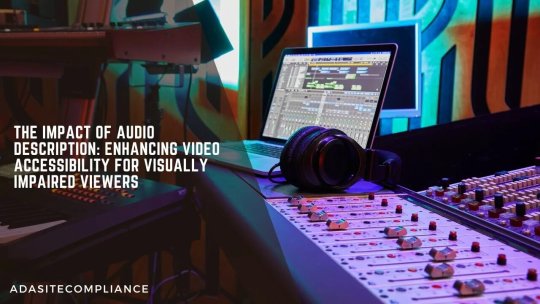
Legal Compliance For Video Accessibility
ADA Site Compliance ensures legal compliance for video accessibility through our audio description services, meeting all required standards and regulations!
#audio description#video accessibility#visually impaired viewers#enhancing video accessibility#standard audio description#extended audio description#live audio description#inclusive viewing experience#spoken narration for visual elements#accessible content#accessibility standards#visual media accessibility#section 508 compliance#audio description benefits#visual impairment#accessible storytelling#narration of visual elements#legal compliance for video accessibility#creating audio descriptions#accessible multimedia content#audio description technology#audio description services#website accessibility solutions#ADA site compliance#ADASiteCompliance#adasitecompliance.com
0 notes
Text
Beyond Boundaries: Creating Inclusive Outdoor Spaces

View On WordPress
#accessibility#accessibility advocacy#accessibility initiatives#accessibility standards#accessible camping#accessible gardens#accessible hiking trails#accessible landscapes#accessible natural areas#accessible nature trails#accessible outdoor adventures#accessible outdoor amenities#accessible outdoor events#accessible outdoor experiences#accessible outdoor facilities#accessible parks#accessible playgrounds#accessible tourism#accessible trails#barrier removal#barrier-free#barrier-free environments#Community Engagement#disabilities#disability inclusion#disability rights#disability-friendly#diversity#diversity and inclusion#environmental justice
0 notes
Text
How to Set the PDF UA Identifier in Adobe Acrobat Pro
Learn to set the PDF UA identifier in Adobe Acrobat Pro DC for accessible document compliance. #PDFUA #Accessibility #AdobeAcrobat #DocumentCompliance #AccessiblePDF #ProDCTips #AccessibilityStandards
Today we’re learning how to set the PDF UA identifier using Adobe Acrobat Pro DC. This is one of many essential steps in ensuring your document is PDF UA compliant, which is crucial for accessibility to all users. Video Guide The PDF UA Identifier is a piece of metadata contained within the document properties. The identifier tells users that the document claims technical compliance with PDF UA…
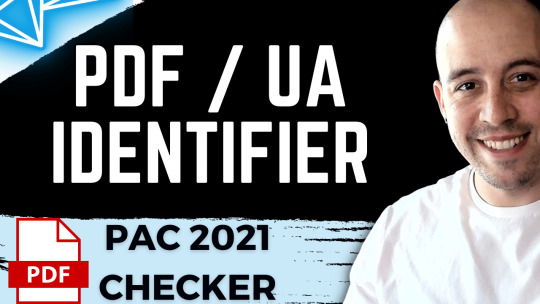
View On WordPress
#Accessibility#Accessibility Standards#Acrobat Pro DC#adobe acrobat#Document Compliance#pdf accessibility#PDF UA
0 notes
Text
#Cognitive Accessibility#WCAG#Section 508#Disabilities#Screen Readers#Color Contrast#Cognitive Disabilities#Content Accessible#Design Principles#Designer Accessibility#Web Content#Learning Disabilities#Making Content#Accessibility Guidelines#Accessibility Testing#Designing Web Content#Inclusive Design#Accessibility Standards#Accessibility Criteria#Accessibility Expert#Web accessibility#AEL Data
0 notes
Text
Does My Website Need To Be ADA-Compliant?
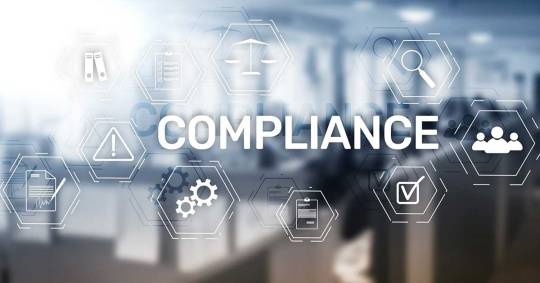
Does my website need to be ADA-compliant? Suppose you own a business or organization with a website and people visit your site in order to obtain information about or purchase your products or services. In that case, your site needs to comply with ADA regulations. Websites should be accessible to all individuals regardless of their ability or disability. The ADA is the principal civil rights statute for people with disabilities. Under Title III of the ADA, businesses and nonprofit service providers must make reasonable modifications in policies and procedures to permit access for all people, including those with disabilities.
In this guide, learn if your website needs to be ADA-compliant and what the ADA requires of your business.
Yes, it does.
The Americans with Disabilities Act (ADA) is a civil rights law that prohibits discrimination based on disability. It applies to all places of public accommodation, including websites that are part of those businesses.
Websites should be accessible to all individuals regardless of their ability or disability.
In the United States, the Americans with Disabilities Act (ADA) was signed into law in 1990, which requires all businesses and organizations to provide equal access to their goods and services. Websites should be no exception!
The ADA covers a wide range of conditions that may affect one’s ability to interact with others in various ways. These include: blindness/visual impairment; deafness/hard-of-hearing; autism spectrum disorder; cerebral palsy; diabetes; epilepsy or other seizure disorders; intellectual disability; learning disabilities and/or ADHD (attention deficit hyperactivity disorder); muscular dystrophy; multiple sclerosis or other degenerative brain diseases similar in nature; stroke, traumatic brain injury (TBI)/post-concussive syndrome.
The ADA is the principal civil rights statute for people with disabilities.
The ADA also prohibits discrimination based on disability in all programs, activities, and services offered by public entities. It applies to each of us – doctors, nurses, hospitals; restaurants and hotels; landlords who rent apartments or houses; theaters – any place we go to purchase something or do business.
However, what amounts to “reasonable” will vary from case to case. The law provides several factors for determining whether an accommodation is reasonable: best practices in the industry at issue; other relevant federal laws and regulations that require compliance with standards similar to or more stringent than those required by Title III (for example: Section 508); the resources available at that particular site; whether there are alternative ways of meeting both legitimate concerns raised by the organization as well as its legal obligations under Title III; what types of accommodations other customers without disabilities typically receive at that location or venue; how often customers without disabilities experience difficulties accessing such facilities due to structural barriers; whether making a change would be impracticable because it would produce significant economic hardship on small business owners who operate limited-service restaurants or retail stores catering primarily toward one sex or gender-based upon stereotypes about manners associated with certain genders (which might warrant a finding that allowing individuals into these locations would fundamentally alter their operations).
Legal action has already been taken against businesses where it was determined that their website was not compliant with ADA rules.
ADA compliance is not a suggestion, it’s a requirement. If you run any sort of business that has a physical presence, and if more than one person is present at that business, then ADA compliance applies to you.
This includes everything from the most basic retail store to your own website and digital presence. If you offer goods or services online (even if they’re free), then ADA compliance applies to your website as well.
The government has also made clear that they’re not just interested in large businesses when it comes to ADA rules—they want every business owner and operator on board. The law states: “The Americans with Disabilities Act requires all public entities…to ensure effective communication with individuals with disabilities.”
Web Content Accessibility Guidelines.
The Web Content Accessibility Guidelines (WCAG) 2.1 became effective on June 5, 2018. WCAG 2.1 builds upon WCAG 2.0 to ensure compliance with ADA regulations and laws by providing website owners with guidelines for ensuring that the content on their websites is accessible to all users, including those who have physical or mental disabilities. These include visual impairments (low vision, color blindness), hearing loss, physical limitations (mobility impairments), and cognitive limitations (dyslexia and language disorders).
The updated guidelines can be applied immediately when making changes to existing websites or content or planning new ones, even if a site hasn’t been built yet.
Conclusion
Keeping up with the latest web accessibility guidelines is important, but it’s not always easy. If you’re looking for ways to improve your website’s compliance with ADA standards or just want to ensure that it complies with other legal obligations, contact the experts at Reversed Out Creative today!
Contact Us
At Reversed Out Creative, we understand the challenges and opportunities presented by AI disruption. Our team of experts specializes in web design, SEO, graphic design, and digital marketing services. Reach out to us through our contact form to learn more about navigating the evolving job market and embracing the potential of AI. Together, let’s shape a future that combines human ingenuity with the power of AI.
Original content source: https://reversedout.com/does-my-website-need-to-be-ada-compliant/
#ADA compliance#Website accessibility#Accessibility standards#Web accessibility guidelines#Web accessibility best practices#The Americans with Disabilities Act
0 notes
Text
Revolutionizing Accessibility: The Journey of Scribley and the Future of Alt Text
"Yes if I could wave a magic wand then organisations would hold themselves accountable to the Alt text that they are publishing just like any other content they are publishing. It's part of that process" #axschat
Introduction In a recent enlightening Axschat podcast, Caroline Desrosiers, the founder of Scribley, shared her insights into the evolving world of digital accessibility, mainly focusing on Alt text and its crucial role in content accessibility. The Genesis of Scribley Caroline’s journey began in digital publishing, where she first encountered the challenges of image descriptions in…

View On WordPress
#Accessibility Advocacy#Accessibility Solutions#Accessibility Standards#Accessible Publishing#AI and Accessibility#Alt Text Innovation#Antonio Vieira Santos#Content Creation#Digital Accessibility#EU Accessibility Directive#Image Descriptions#Inclusive Design#Inclusive Web Development#Multilingual Accessibility#Scribley#Web Content Accessibility
0 notes
Text
Accessibility in learning is an essential component in developing eLearning content that people with a range of abilities can easily access. Accessibility standards provide instructional and graphic designers with the much-needed guidance to design accessible eLearning content that all learners – including those with disabilities – are able to access. Accessible content benefits all learners and improves personal and organizational .
0 notes
Text
You should be using an RSS reader

On OCTOBER 23 at 7PM, I'll be in DECATUR, GEORGIA, presenting my novel THE BEZZLE at EAGLE EYE BOOKS.

No matter how hard we all wish it were otherwise, the sad fact is that there aren't really individual solutions to systemic problems. For example: your personal diligence in recycling will have no meaningful impact on the climate emergency.
I get it. People write to me all the time, they say, "What can I change about my life to fight enshittification, or, at the very least, to reduce the amount of enshittification that I, personally, experience?"
It's frustrating, but my general answer is, "Join a movement. Get involved with a union, with EFF, with the FSF. Tell your Congressional candidate to defend Lina Khan from billionaire Dem donors who want her fired. Do something systemic."
There's very little you can do as a consumer. You're not going to shop your way out of monopoly capitalism. Now that Amazon has destroyed most of the brick-and-mortar and digital stores out of business, boycotting Amazon often just means doing without. The collective action problem of leaving Twitter or Facebook is so insurmountable that you end up stuck there, with a bunch of people you love and rely on, who all love each other, all hate the platform, but can't agree on a day and time to leave or a destination to leave for and so end up stuck there.
I've been experiencing some challenging stuff in my personal life lately and yesterday, I just found myself unable to deal with my usual podcast fare so I tuned into the videos from the very last XOXO, in search of uplifting fare:
https://www.youtube.com/@xoxofest
I found it. Talks by Dan Olson, Cabel Sasser, Ed Yong and many others, especially Molly White:
https://www.youtube.com/watch?v=MTaeVVAvk-c
Molly's talk was so, so good, but when I got to her call to action, I found myself pulling a bit of a face:
But the platforms do not exist without the people, and there are a lot more of us than there are of them. The platforms have installed themselves in a position of power, but they are also vulnerable…
Are the platforms really that vulnerable? The collective action problem is so hard, the switching costs are so high – maybe the fact that "there's a lot more of us than there are of them" is a bug, not a feature. The more of us there are, the thornier our collective action problem and the higher the switching costs, after all.
And then I had a realization: the conduit through which I experience Molly's excellent work is totally enshittification-proof, and the more I use it, the easier it is for everyone to be less enshittified.
This conduit is anti-lock-in, it works for nearly the whole internet. It is surveillance-resistant, far more accessible than the web or any mobile app interface. It is my secret super-power.
It's RSS.
RSS (one of those ancient internet acronyms with multiple definitions, including, but not limited to, "Really Simple Syndication") is an invisible, automatic way for internet-connected systems to public "feeds." For example, rather than reloading the Wired homepage every day and trying to figure out which stories are new (their layout makes this very hard to do!), you can just sign up for Wired's RSS feed, and use an RSS reader to monitor the site and preview new stories the moment they're published. Wired pushes about 600 words from each article into that feed, stripped of the usual stuff that makes Wired nearly impossible to read: no 20-second delay subscription pop-up, text in a font and size of your choosing. You can follow Wired's feed without any cookies, and Wired gets no information about which of its stories you read. Wired doesn't even get to know that you're monitoring its feed.
I don't mean to pick on Wired here. This goes for every news source I follow – from CNN to the New York Times. But RSS isn't just good for the news! It's good for everything. Your friends' blogs? Every blogging platform emits an RSS feed by default. You can follow every one of them in your reader.
Not just blogs. Do you follow a bunch of substackers or other newsletters? They've all got RSS feeds. You can read those newsletters without ever registering in the analytics of the platforms that host them. The text shows up in black and white (not the sadistic, 8-point, 80% grey-on-white type these things all default to). It is always delivered, without any risk of your email provider misclassifying an update as spam:
https://pluralistic.net/2021/10/10/dead-letters/
Did you know that, by default, your email sends information to mailing list platforms about your reading activity? The platform gets to know if you opened the message, and often how far along you've read in it. On top of that, they get all the private information your browser or app leaks about you, including your location. This is unbelievably gross, and you get to bypass all of it, just by reading in RSS.
Are your friends too pithy for a newsletter, preferring to quip on social media? Unfortunately, it's pretty hard to get an RSS feed from Insta/FB/Twitter, but all those new ones that have popped up? They all have feeds. You can follow any Mastodon account (which means you can follow any Threads account) via RSS. Same for Bluesky. That also goes for older platforms, like Tumblr and Medium. There's RSS for Hacker News, and there's a sub-feed for the comments on every story. You can get RSS feeds for the Fedex, UPS and USPS parcels you're awaiting, too.
Your local politician's website probably has an RSS feed. Ditto your state and national reps. There's an RSS feed for each federal agency (the FCC has a great blog!).
Your RSS reader lets you put all these feeds into folders if you want. You can even create automatic folders, based on keywords, or even things like "infrequently updated sites" (I follow a bunch of people via RSS who only update a couple times per year – cough, Danny O'Brien, cough – and never miss a post).
Your RSS reader doesn't (necessarily) have an algorithm. By default, you'll get everything as it appears, in reverse-chronological order.
Does that remind you of anything? Right: this is how social media used to work, before it was enshittified. You can single-handedly disenshittify your experience of virtually the entire web, just by switching to RSS, traveling back in time to the days when Facebook and Twitter were more interested in showing you the things you asked to see, rather than the ads and boosted content someone else would pay to cram into your eyeballs.
Now, you sign up to so many feeds that you're feeling overwhelmed and you want an algorithm to prioritize posts – or recommend content. Lots of RSS readers have some kind of algorithm and recommendation system (I use News, which offers both, though I don't use them – I like the glorious higgeldy-piggeldy of the undifferentiated firehose feed).
But you control the algorithm, you control the recommendations. And if a new RSS reader pops up with an algorithm you're dying to try, you can export all the feeds you follow with a single click, which will generate an OPML file. Then, with one click, you can import that OPML file into any other RSS reader in existence and all your feeds will be seamlessly migrated there. You can delete your old account, or you can even use different readers for different purposes.
You can access RSS in a browser or in an app on your phone (most RSS readers have an app), and they'll sync up, so a story you mark to read later on your phone will be waiting for you the next time you load up your reader in a browser tab, and you won't see the same stories twice (unless you want to, in which case you can mark them as unread).
RSS basically works like social media should work. Using RSS is a chance to visit a utopian future in which the platforms have no power, and all power is vested in publishers, who get to decide what to publish, and in readers, who have total control over what they read and how, without leaking any personal information through the simple act of reading.
And here's the best part: every time you use RSS, you bring that world closer into being! The collective action problem that the publishers and friends and politicians and businesses you care about is caused by the fact that everyone they want to reach is on a platform, so if they leave the platform, they'll lose that community. But the more people who use RSS to follow them, the less they'll depend on the platform.
Unlike those largely useless, performative boycotts of widely used platforms, switching to RSS doesn't require that you give anything up. Not only does switching to RSS let you continue to follow all the newsletters, webpages and social media accounts you're following now, it makes doing so better: more private, more accessible, and less enshittified.
Switching to RSS lets you experience just the good parts of the enshitternet, but that experience is delivered in manner that the new, good internet we're all dying for.
My own newsletter is delivered in fulltext via RSS. If you're reading this as a Mastodon or Twitter thread, on Tumblr or on Medium, or via email, you can get it by RSS instead:
https://pluralistic.net/feed/
Don't worry about which RSS reader you start with. It literally doesn't matter. Remember, you can switch readers with two clicks and take all the feeds you've subscribed to with you! If you want a recommendation, I have nothing but praise for Newsblur, which I've been paying $2/month for since 2011 (!):
https://newsblur.com/
Subscribing to feeds is super-easy, too: the links for RSS feeds are invisibly embedded in web-pages. Just paste the URL of a web-page into your RSS reader's "add feed" box and it'll automagically figure out where the feed lives and add it to your subscriptions.
It's still true that the new, good internet will require a movement to overcome the collective action problems and the legal barriers to disenshittifying things. Almost nothing you do as an individual is going to make a difference.
But using RSS will! Using RSS to follow the stuff that matters to you will have an immediate, profoundly beneficial impact on your own digital life – and it will appreciably, irreversibly nudge the whole internet towards a better state.

Tor Books as just published two new, free LITTLE BROTHER stories: VIGILANT, about creepy surveillance in distance education; and SPILL, about oil pipelines and indigenous landback.
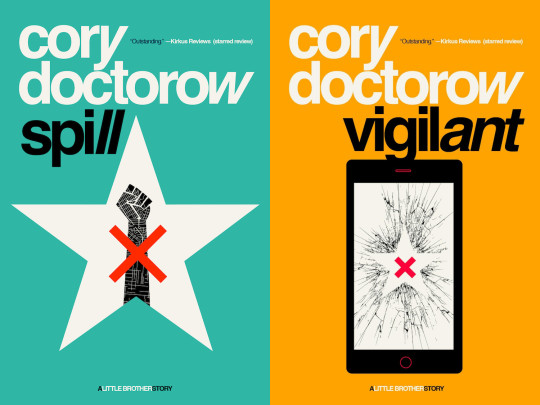

If you'd like an essay-formatted version of this post to read or share, here's a link to it on pluralistic.net, my surveillance-free, ad-free, tracker-free blog:
https://pluralistic.net/2024/10/16/keep-it-really-simple-stupid/#read-receipts-are-you-kidding-me-seriously-fuck-that-noise
1K notes
·
View notes
Text
The Importance of Video Accessibility for Your Audience

Discover why video accessibility matters to your audience. Explore the benefits of providing captions, transcripts, and audio descriptions in videos to ensure inclusivity, improve user experience, and reach a wider audience. Enhance the accessibility of your videos and make a meaningful impact today. For more details, checkout the blog:
#Video Accessibility#Inclusive Content#User Experience#Accessibility Standards#Reaching a Wider Audience
0 notes
Text
I'm sorry but the irony of Nico calling Max unprofessional is sending me so bad like sir there's an entire garage full of people, who were literally in the trenches trying to survive the Brocedes fallout while just doing their jobs, who might have a few things to say about your (& Lewis') level of professionalism at that time 😭✋️
#f1#formula 1#formula one#max verstappen#nico rosberg#lewis hamilton#brocedes#like niki lauda had to try multiple times to literally parent trap them to try and get them on speaking terms it never worked#because one would arrive they'd see the other and the other would leave#& if i remember correctly the garage crew would swap around from race to race as a like see we aren't favouring anybody gesture 😭#and thats no shade to nico because it was both of them contributing to that environment#his comment re max is just making me laugh#like if i was a part of the pr/media team - which is a part of the degree I'm working on irl - at merc that year i would've lost the plot#like its insane reflecting on it nearly a decade later but the poor souls just trying to do their job in the eye of that storm#truly gods strongest soldiers#ngl the professional comment irks me a bit because its not like max is engaging in inappropriate work place behaviour#he's engaging in another aspect of racing that his involvement raises awareness of & that makes racing more accessible#& we all know how inaccessible not only getting into racing is but also to continue to pursue the further along you go#theres so many stories of 1 sibling giving up racing so the other can keep going because the family can't afford for them both to race#its a huge financial strain & we only see a handful of drivers talk about that & try to do something to change it#and nicos fellow sky sports commentators are routinely unprofessional on so many levels#additionally max had a lot of valid reasons to be annoyed at his team today#but alas he's not english so he's ungrateful#i hate that drivers can't criticise their teams or car without immediately being branded as bratty & ungrateful#ESPECIALLY WHEN THEIR JOB IS TO GIVE FEEDBACK#you can see the double standards from sky when say Lando or George have complaints with their team/car v the likes of Max and Yuki#especially Yuki my god the things i would do to get the British media to leave him alone#this was a jokey post at one point and then became a rant whoops lmao#I'll leave it that before i write an actual essay here 😭✋️
555 notes
·
View notes
Text
no, but really, we need to talk about the casual objectification that has become the fallback discourse of the internet: if you're pretty and dressed nicely, you're a slut. and if you're even vaguely outside of their body standard, you're fucking disgusting.
too-frequently, people position sex workers as being "the problem". they sneer you're addicted to pornography, you don't know what a real woman looks like. but real women are in pornography. the real bodies on display are not the issue here: the issue is that other people feel extremely confident when commenting on someone's physique.
2000's super-thin is slowly worming its way back into the public ideal. recently i saw someone get told to "go for a run", despite the fact she was on the thinner side of average. not that it would ever be appropriate to say that: but it's kind of like sticker shock when you see it. people think that is fat? holy shit. do they just have no idea about things?
but what are you going to do about it? that's the problem, right. because chances are - you're a normal person. we can say normalize carrying fat on your body, but we are not the billion-dollar diet industry. we are not the billion-dollar fashion industry. we are just, like. people. who are trying to make content on the internet, without being treated shittily.
as someone who has been on both sides of things: you are treated better when you are thin and pretty. this is statistically correct. i am not saying that you cannot be bullied for being thin; i'm saying there are objective institutional biases against certain bodytypes. there are videos of men and women who lost weight all saying: i now know for a fact exactly how much worse you're treated. in the comments, some asshole inevitably says something akin to you deserved to be dehumanized when you were fat.
which means that ... the easiest thing to do is be pretty and thin. it is the path of least resistance, because of course it is, because any time you post a picture of yourself without a thigh gap, someone immediately comments something like you need to try a diet.
the other half is also dehumanizing though, huh, just in a different way. when i put on makeup and nice clothes, i am told i slept my way to the top as a professional. do you know how many women in STEM have told me they purposefully dress to "unimpress" because they already struggle to be taken seriously and if they're ever considered pretty - it for some reason takes away from their authority.
so they make it seem like it's your fault. you, existing in a body - it's your fault! if you didn't want shitty comments, don't have a body. they position us against each other like chess pieces; vying for male attention we don't even need.
and i can be an authority on this unless you think i'm fat and unattractive. when i am pretty and thin, i'm an activist. when i am just a normal person who makes a good point: i am immediately dismissed. nobody fucking believes you if you're not seen as attractive. you literally lose value. you cease to exist.
but the whole time, it feels like - is anyone actually grounded the fuck in reality? the line of "pretty and thin" keeps shifting. nobody seems to understand what "a normal weight" even looks like, because it's not something that exists - you cannot tell a person's health by looking at their body. even if you think you could tell that, even if you're sure a person is dangerously overweight - people are not your dolls. they do not need to be dressed up or displayed properly to soothe your aesthetics. you aren't concerned for them, you're stealing their agency. you don't get to say if they're "allowed" to take pictures and post them on the internet - you don't get to tell them how to exist.
people hide behind "the obesity epidemic" without any actual qualifications. they crow things about "normalizing unhealthiness".
but it's bullshit. i have visible abs. there is a pair of parallel lines on my body, even when i'm relaxed; where my obliques meet my abdominal wall. i am proud of this because it means i'm strong, because i overcame an eating disorder only to be ripped as fuck. it is genetic and physical luck that i even get any definition, i'm pleased as punch.
but it does mean that my abdominal wall sticks out a little bit. the other day i posted a video of myself dancing, and, for a moment, my shirt slipped. you could see a little bit of my stomach. i was cartwheeling to the floor. moments before this, i'd had my foot over my head.
a guy slid into my DMs. a row of vomiting emojis prefaced: you should really lose some weight before you think about dancing.
i stared at it for a long time. there was a time when i would have been triggered by this, where it would have encouraged me to starve myself. i would have ignored the fact i'm flexible, agile, good at jumping: i would have lost the weight for a stranger's passing comment. i would have found myself and my body fucking disgusting.
and for what? to please what? because why? so that he can exist in this world without an unchallenged eyeball? what would my self-hatred even accomplish? usually i write paragraphs. obviously. on this particular occasion, in this body i've been at war with for ages: i just felt exhausted.
it shouldn't be even worth saying. it shouldn't be hard to explain. all of this emotional turmoil when he cannot even comprehend the most basic truth: i am not an object on display for him.
#spilled ink#writeblr#warm up#like if im getting fatshamed. babe......... wake up#is there fat on my body? yes :)#btw this behavior wouldn't be okay even if I WAS overweight!!! that is my point!!!#it is both that people have no idea what weight is supposed to look like#and even if they DID... they do not seem to understand that PEOPLE ARE NOT DOLLS#YOU DO NOT GET TO TELL THEM HOW TO EXIST#if you respond anything akin to ''but raquel there IS an obesity epidemic''#you're blocked and reported.#go fucking DONATE TO A FOOD BANK THEN. volunteer in a food desert. start a free fitness program#GO GET A DEGREE AS A MEDICAL PROFESSIONAL AND PRACTICE IN NUTRITION IN UNDERPRIVILEDGED LOCATIONS#FIGURE OUT HOW TO LOWER FOOD COSTS. FIGURE OUT HOW TO NORMALIZE AND STANDARDIZE#ACCESS TO FARM-FRESH FOOD. PROVIDE ACTUAL FREE ACCESS TO OUTSIDE ACTIVITIES#FIGURE OUT HOW TO TEACH PEOPLE HEALTHY CHOICE MAKING WHILE ALSO LOWERING THE COST OF MEALS.#THE AVERAGE GROCERY BILL OF THE AMERICAN CITIZEN HAS QUADRUPILED IN THE LAST YEAR.#SHUT. THE FUCK. UP!!!!!!!!!#you don't want to help these people!!!!!#you want to bully them but still feel like a good person!#you want to be justified in your hatred of an entire CLASS of people!!!#you don't give a fuck about how it makes them feel!!!!#you care ONLY about whether or not YOU get to VIRTUE SIGNAL that YOURE so thin and pretty!!!!#it is BECAUSE of people like you#and the fact you tolerate fatphobia - BECAUSE of that normalization. that men like the one who called me fat#feel like they can get away with it.#bc there's a line for you where you WOULD be okay with it. where if i WASNT thin you'd be okay with it.#which means the line can always be pushed in a certain direction. and it's always going to appeal to male aesthetics.#''well you didn't deserve it'' maybe fucking NOBODY does babe. maybe we should just all agree not to comment on ppls bodies!!
2K notes
·
View notes
Text
Enhancing Video Accessibility
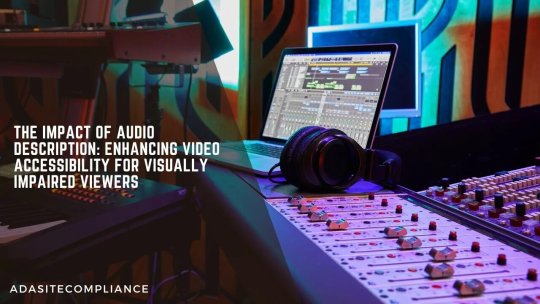
The Impact Of Audio Description: Enhancing Video Accessibility For Visually Impaired Viewers
How do people with visual impairments experience the world of movies and television? Have you ever considered what it’s like to watch a film without seeing the vibrant colors, intricate expressions, or stunning landscapes that make up the visual narrative? In this article, you will learn about the impact of audio description, and how enhancing video accessibility helps to people with visual impairment.
For many with visual impairments, this can lead to disconnection as they miss out on the crucial visual elements that bring a story to their life.
This is where the power of audio description steps in.
Audio description is a groundbreaking technology that provides a spoken narration of the visual elements in movies and TV shows.
It transforms the viewing experience, offering a rich, detailed verbal depiction for those with visual impairments to engage with the story.
It creates an inclusive experience about genuinely participating in the narrative, which is why it is necessary in today’s digital age. Ensuring content is accessible through audio description is a commitment to inclusivity and equality.
At ADA Site Compliance, we understand the critical importance of accessible content. Our team of experts is ready to help you ensure your videos meet the highest accessibility standards, including optimized audio descriptions. Let us work together to ensure your content reaches and resonates with all audiences.
What Is an Audio Description?
Audio description provides a spoken narration of visual elements in media, including movies, television shows, and live performances. This service helps blind or visually impaired individuals better understand and enjoy the content, enhancing their overall experience.
It vividly portrays actions, images, gestures, and settings, enabling visually impaired viewers to follow the flow of events, grasp the emotional character undertones, and appreciate the storyline nuances.
Besides, adding audio descriptions also benefits distracted viewers or viewers who find it difficult to focus on the film’s visual aspects. The additional narrative context and richness enhance the viewing experience for a broader audience, making it an indispensable tool for truly inclusive media.
Understanding the Types of Audio Description for Visual Media
Audio description comes in various forms, each tailored to different types of content and specific viewing needs.
1. Standard Audio Description
This is the most widely used format. It delivers concise narrations of key visual elements during natural pauses in dialogue. It ensures a seamless and uninterrupted viewing experience, allowing the narrative to flow smoothly without disrupting the content’s rhythm.
2. Extended Audio Description
Extended audio descriptions offer a more detailed description and narration for intricate visuals or fast-paced action. It goes beyond the basics, providing in-depth explanations of the setting, characters, and actions to give viewers a fuller understanding of the visual subtleties crucial to the storyline.
3. Internet and Interactive Media Audio Description
These descriptions make web pages and multimedia content accessible by covering visual elements such as images and graphics. They thus make digital content more inclusive for users who are blind or use screen readers or other assistive technologies.
They ensure fully accessible pre-recorded multimedia content by meeting essential accessibility standards like the W3C WCAG, Section 508, and EU regulations.
4. Live Audio Description
These descriptions are more in real-time settings like theater performances or live sports events, offering detailed costumes and scene changes or field actions. Like sports commentators, trained narrators describe actions on stage or the field, focusing more on visual details.
The live audio description brings immediacy and engagement to live events for those who might otherwise miss out on the visual aspects.
Each audio description type plays a vital role in making content accessible and enhancing the viewing experience for visually impaired audiences.
Six Advantages of Audio Description Services
By providing detailed explanations of visual elements, audio description ensures that everyone can fully engage with and appreciate the content. Accessibility for visually impaired individuals prevents their exclusion from films, television, and other visual media.
Here are some critical advantages of audio description accessibility:
Enhanced Accessibility: Audio description significantly expands the reach of your content, making it accessible to a large audience of visually impaired individuals.
Increased Versatility: Audio descriptions add flexibility to how your content is consumed. Audiences can enjoy your material by listening while multitasking.
Improved Language Acquisition: Audio description helps with language development in individuals with autism. Linking words with visual elements enhances vocabulary, comprehension, and overall language skills.
Better Understanding of Social Cues: Audio description helps individuals with autism better understand the emotional and social cues conveyed through facial expressions and body language.
Enhanced Auditory Learning: For many, auditory learning helps absorb the essential visual elements that may be unknowingly missed. Audio description enhances the auditory learning experience, making it easier to retain information and grasp complex topics.
Legal Compliance: In many cases, audio description is legally needed to ensure content accessibility for individuals with disabilities. Failing to comply with these accessibility standards can lead to costly legal repercussions.
By incorporating audio description into your web content accessibility guidelines, you improve accessibility and affirm your commitment to diversity and equal opportunity for all.
How to Create Audio Description?
Creating audio descriptions is a meticulous process, and following these five essential steps helps truly enhance accessibility:
Step 1: Conduct a Comprehensive Content Analysis of All Visual Elements
Begin by thoroughly reviewing your video and identifying all significant visual elements that require explanation. This includes actions, facial expressions, scene transitions, on-screen text, sound effects, and other components contributing to the story or understanding.
Step 2: Draft a Clear and Concise Script
The next step is to craft an easy-to-understand script with a video description of important visual elements. It should seamlessly blend with the existing audio track without technical jargon. Use the present tense to create audio descriptions while maintaining a sense of immediacy. Break down complex scenes into smaller, digestible segments, and keep the script engaging and informative.
Step 3: Record the Audio with the Help of a Professional Voice Artist
Engage a skilled voice artist experienced in audio description to record your script. Their clear and articulate delivery and descriptive narration in the desired pace, tone, and style enhance the listening experience.
Step 4: Edit and Synchronize the Audio Description As Appropriate
Carefully edit the recorded audio description to align with the video timing and fit into the pauses in dialogue and background sounds. Review the extended description script for inconsistencies, errors, or unclear sections and make necessary adjustments for a smooth and coherent flow.
Step 5: Conduct Rigorous Quality Assurance
Evaluate the final audio description to ensure clarity, accuracy, and effectiveness in conveying information. Seek feedback from visually impaired individuals or consult accessibility experts to identify potential issues or missing essential visual audio elements. Revise as needed to guarantee that the audio description meets the highest standards of quality and accessibility.
The Evolution of Audio Description Technology
With the rapid advancement of technology, audio description has seen significant progress, enhancing its effectiveness and reach. Modern tools, innovative software, and refined methods have revolutionized how audio descriptions are created and delivered.
These technological advancements are not just about convenience—they enable individuals with visual impairments to engage with and participate in society.
Essential Tools for Creating High-Quality Audio Descriptions
A meticulously crafted script is the foundation of effective audio description. Some tools offer robust scriptwriting capabilities, including automatic formatting, collaboration features, and version control. These capabilities are indispensable for creating precise and accurate scripts and critical for delivering a seamless and engaging audio description experience.
Once the script is ready, record and refine the audio using tools to capture audio recording, editing, and mastering audio. These applications ensure the final audio description is clear, professional, and fully immersive, enhancing the viewer’s experience.
Accurate transcription is another crucial component of high-quality audio description, and some tools offer fast and reliable transcription services. This allows creators to focus on producing high-quality audio descriptions without wasting time on manual transcription, ensuring that every detail of entertainment audio description is captured accurately.
Future of Audio Description and Accessibility
The future of audio description is promising and evolving rapidly. As technology advances, the quality and accessibility of audio-described content are set to reach new heights. Innovations in AI and machine learning are paving the way for more efficient and accurate creation of audio descriptions, making it easier than ever to ensure that content is accessible to all.
These advancements mean that audio description will become an even more integral part of media creation. However, technology alone is not enough to achieve true accessibility. Collaboration is key. For audio description to reach its full potential, content creators, accessibility experts, and the visually impaired community must work together.
By sharing knowledge, expertise, and experiences, we can drive innovation and make media more inclusive for everyone. This collaborative effort is essential in ensuring that the audio description meets the technical requirements and resonates with the audience it serves.
Audio description is vital to inclusivity, making video content accessible to everyone. It allows visually impaired individuals to engage fully with films and television, fostering a sense of belonging and participation.
At ADA Site Compliance, we are dedicated to helping you create accessible content that meets the highest standards. Our team of experts is ready to assist you in integrating audio descriptions and other essential accessibility features into your videos. Together, we can build a more inclusive future where everyone can enjoy the magic of storytelling!
youtube
#audio description#video accessibility#visually impaired viewers#enhancing video accessibility#standard audio description#extended audio description#live audio description#inclusive viewing experience#spoken narration for visual elements#accessible content#accessibility standards#visual media accessibility#section 508 compliance#audio description benefits#visual impairment#accessible storytelling#narration of visual elements#legal compliance for video accessibility#creating audio descriptions#accessible multimedia content#audio description technology#audio description services#website accessibility solutions#ADA site compliance#ADASiteCompliance#adasitecompliance.com#Youtube
0 notes
Text
i love doing character analysis for minthara because shes such a wonderful hypocrite. she has a lot of deeply reactionary political views but she makes it openly known shes willing to suspend just about all of them because youve become more important to her than nearly anything else. deeply opinionated but never pushes you to do something you wont throw your weight behind, and if your her partner shell suspend all the "survival of the fittest" cultural upbringing she finds so much sense and empowerment in to make an exception for you specifically and no one else.
i love her
#bg3#bg3 minthara#minthara#minthara baenre#she 100% doesnt care that flights regularly violate ACA standards until they damage YOUR wheelchair specifically#and then she is an absolute NIGHTMARE pulling out every citation in the book and as soon as you get home shes making phone calls for 3 days#she wont fight for anyone else but she WILL fight tooth and nail for YOUR accomodations ANNND compensation for emotional damage on top#ur neighborhood is about to get every award for disability accessibility ur city can hand out. minthy will NOT settle for anything less
229 notes
·
View notes
Text
How to tag a link in PDF
Immerse yourself in a detailed tutorial on making PDF links accessible. Learn to ensure your documents are usable for everyone.
This post will go over how to tag a link/hyperlink within a PDF using Adobe Acrobat Pro DC. Video Overview Lets dive right in! Links tags need to be structured in a very specific way. Here is that way: P > Link > Link-OBJR and Link text Here is an example. Links do not always need to be children tags to P tags, but they can never exist as the parent tag themselves. Don’t forget the link…
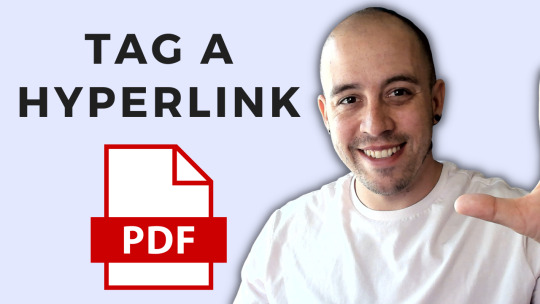
View On WordPress
#Accessibility Standards#digital accessibility#Making PDF Links Accessible#pdf accessibility#W3C Web Accessibility Initiative
0 notes